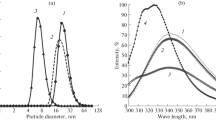Abstract
WE have examined in the ultracentrifuge crystalline pepsin, prepared by a method closely resembling that of Northrop1, using both the velocity and the equilibrium methods2. The velocity method gave a sedimentation constant of 3.3 × 1013, as a mean of seven determinations having an estimated standard deviation of 0.15 × lO13. The equilibrium method gave a molecular weight of 35,500 as a mean of two determinations, the individual figures being 34,400 and 36,600. Comparison of the molecular weight with the sedimentation constant shows that the molecule is spherical. Although, owing to the small number of determinations, these figures are only provisional, they lead to the same conclusion as Northrop's osmotic and diffusion data, namely, that as regards molecular weight and shape, Northrop's crystalline pepsin belongs to the same class of proteins as ovalbumin, Bence Jones protein and insulin. This conclusion is independent of whether the peptic activity is a property of the protein molecule or of an active group adsorbed on its surface.
Similar content being viewed by others
References
Northrop, J. Gen. Physiol, 13, 739, 1930.
Compare, NATURE, 123, 871, June 8, 1929.127, 438, March 21, 1931. 130, 434, Sept. 17, 1932.
Northrop, J. Gen. Physiol, 14, 713, 1931.
Author information
Authors and Affiliations
Rights and permissions
About this article
Cite this article
PHILPOT, J., ERIKSSON-QUENSEL, IB. An Ultracentrifugal Study of Crystalline Pepsin. Nature 132, 932–933 (1933). https://doi.org/10.1038/132932b0
Issue Date:
DOI: https://doi.org/10.1038/132932b0
- Springer Nature Limited
This article is cited by
-
Die Struktur der Proteine im Lichte der R�ntgenstrahlen
Die Naturwissenschaften (1937)
-
�ber den Aufbau der Eiwei�molek�le
Kolloid-Zeitschrift (1937)
-
X-Ray Photographs of Crystalline Pepsin
Nature (1934)




